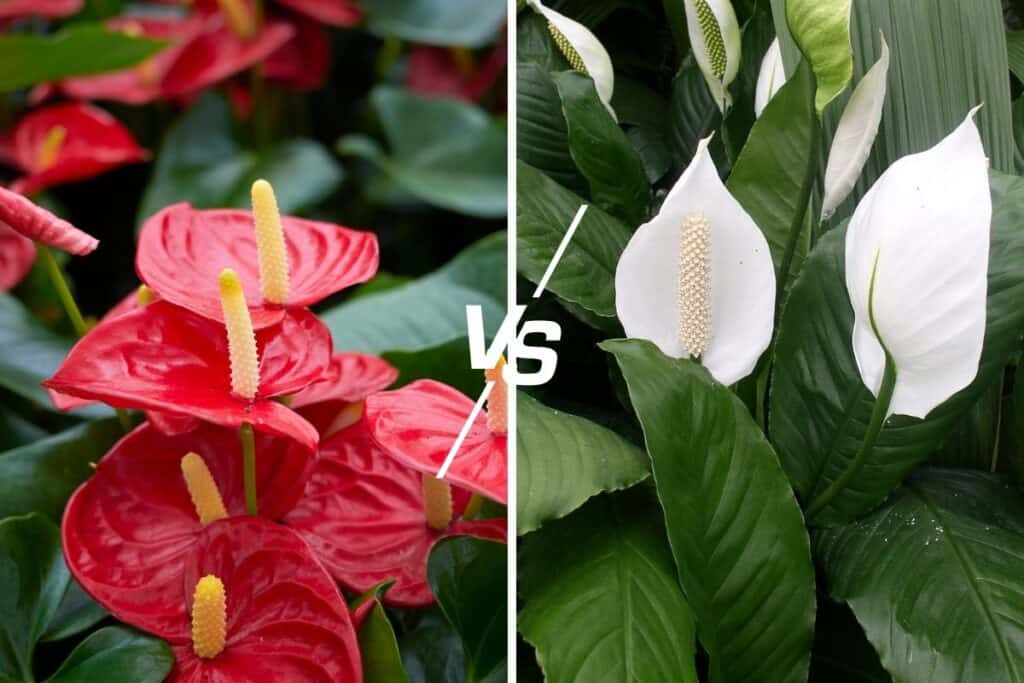If you’re new to indoor gardening, you’ve probably seen both Anthuriums and Peace Lilies at your local garden center. They’re two of the most popular tropical houseplants—and for good reason! Both offer beautiful blooms and help clean the air. But when it comes to plant care, they’re pretty different. So which one is easier to grow indoors? Let’s break it down by comparing their light needs, watering habits, blooming patterns, and more.

☀️ Light Requirements: Which Plant Handles Low Light Better?
Anthurium plants love bright, indirect light for at least 6 hours a day. If they get too much direct sunlight, their leaves can burn. Without enough light, they won’t bloom well.
Peace lilies, on the other hand, are more flexible. They can grow in low light and still look great, even if they don’t flower as often. You can place them 5–8 feet from a north-facing window and they’ll still thrive. If your home doesn’t get much natural light, peace lilies are the better choice.
💧 Watering & Humidity: What Do These Plants Need?

Both plants like moist soil, but their watering schedules are different:
- Peace lilies need water when the top inch of soil feels dry—usually every 5–7 days.
- Anthuriums prefer to dry out a bit more between waterings—about every 7–10 days.
When it comes to humidity, anthuriums are pickier. They love 70–80% humidity, which you can create with a pebble tray or humidifier. Peace lilies are more relaxed and do fine with 40–50% humidity, though they’ll enjoy a misting during dry months.
🌡️ Temperature & Growing Conditions
These tropical plants like warm temperatures, but they have different limits:
- Anthuriums grow best between 70–85°F (21–29°C). Keep them away from cold drafts or air conditioning vents.
- Peace lilies can handle cooler temps, from 65–80°F (18–27°C), but don’t let them drop below 45°F (7°C).
Both prefer bright, indirect light, but peace lilies are more adaptable to lower light.
🌸 Blooming Patterns: What Do the Flowers Look Like?
Anthuriums can bloom year-round if they’re happy. Their flowers are waxy, heart-shaped spathes in red, pink, or white, and they last 2–3 months.
Peace lilies bloom 2–3 times a year, with elegant white flowers that last about a month. Their blooms have a hooded spathe around a spadix, giving them a classic, graceful look.
If you want colorful, showy flowers, go with anthurium. If you prefer simple, timeless blooms, peace lily is your plant.
🐛 Pests & Disease Resistance
Both plants are pretty tough, but they attract different pests:
- Anthuriums may get spider mites and mealybugs.
- Peace lilies often deal with aphids and scale insects.
Peace lilies are also more resistant to root rot and bacterial infections, making them more forgiving if you accidentally overwater. Anthuriums are more sensitive and can get bacterial blight or fungal issues if their leaves stay wet. To avoid this, don’t water from above and keep air flowing around the plant.
⚠️ Toxicity: Are These Plants Safe for Pets?
Both anthurium and peace lily contain calcium oxalate crystals, which are toxic to pets and humans. If eaten, they can cause mouth pain, swelling, and trouble swallowing.
Keep these plants out of reach—especially from cats and small children. Use hanging baskets, high shelves, or place them in rooms your pets can’t access. If you think your pet has chewed on one, call your vet right away.
Peace lilies are slightly more toxic than anthuriums, but both should be handled with care in pet-friendly homes.
🌿 Final Thoughts: Which One Is Easier?
If you want a plant that’s low-maintenance, handles low light, and is more forgiving, go with the peace lily. It’s perfect for beginners and busy plant parents.
If you’re ready to give a little more attention—especially with humidity and light—and want bold, colorful blooms, then anthurium is a great choice.
Either way, both plants can bring tropical beauty and cleaner air to your home. Just choose the one that fits your space and lifestyle best!
